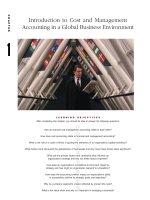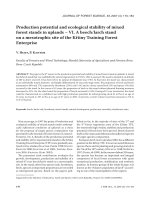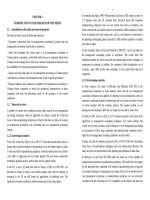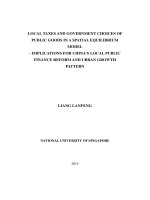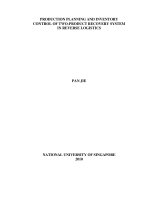ACCOUNTING IN COLLECTING PRODUCTION COST AND CALCULATING COST OF FINISHED GOODS IN HAPRO VODKA JOINTSTOCK COMPANY
Bạn đang xem bản rút gọn của tài liệu. Xem và tải ngay bản đầy đủ của tài liệu tại đây (530.81 KB, 80 trang )
MINISTRY OF FINANCE
ACADEMY OF FINANCE
FACULTY OF FOREIGN LANGUAGE
GRADUATION THESIS
ACCOUNTING IN COLLECTING PRODUCTION COST AND
CALCULATING COST OF FINISHED GOODS IN HAPRO VODKA
JOINTSTOCK COMPANY
DINH THI TRANG
CQ48/51-04
HANOI, 5/2014
MINISTRY OF FINANCE
ACADEMY OF FINANCE
FACULTY OF FOREIGN LANGUAGE
GRADUATION THESIS
ACCOUNTING IN COLLECTING PRODUCTION COST AND
CALCULATING COST OF FINISHED GOODS IN HAPRO VODKA
JOINTSTOCK COMPANY
MAJOR
: English for Finance andAccounting
Code
: 51
STUDENT
: Dinh Thi Trang
GROUP
: CQ48/51-04
SUPERVISOR
: Cao Xuan Thieu, M.A
HANOI, 5/2014
GRADUATION THESIS
DECLARATION
This thesis is the presentation of result of my own research during the
time of internship in Institute of International Finance Education (IIFE), and
has not been submitted for a degree to any other universities or institutions.
To the best of my knowledge, the thesis does not contain material previously
published or another people, except where due acknowledgement is made in
the text.
Hanoi, April 11, 2014.
Dinh Thi Thuy Trinh
DINH THI THUY TRINH - CQ48/51-04
Page 3
GRADUATION THESIS
ABSTRACT
This thesis focuses on the translation quality assessment of the
Vietnamese version of financial and accounting terminologies in Paper F3Financial accounting (International) belonging ACCA program translated by
translators in IIFE. Specifically, it is more concerned with the assessment of
terminologies at word level and above word level in two groups: sub technical
and highly technical group.
The study starts with the introduction by giving a rationale for the
study, pointing out aims, scope and methods of the study.
Chapter I presents the study’s literature review. It elaborates on the
issues relevant to the study including the notion and classification of
translation,
translation
equivalence,
technical
translation,
technical
terminology, translation quality assessment, document review.
Chapter II analyses the source language text and concentrates on
financial and accounting terminologies through document review to arrange
them in sub technical and highly technical group resting with characteristics
of each group. Simultaneously, this chapter also compares the original text
with the translation to evaluate the accuracy of terminologies.
Chapter III summaries the results of study and gives recommendations
for improving the quality of translation.
DINH THI THUY TRINH - CQ48/51-04
Page 4
GRADUATION THESIS
ACKNOWLEDGEMENT
Firstly, I would like to express my profound gratitude to my supervisor
Pham Thi Lan Phuong, M.A, who has continuously encouraged me to
develop my savvy of the subject. Without her motivation, enthusiasm and
intensive expertise, this thesis could not be completed. I also wish to express
my sincere thanks to Tran Minh Thu, M.A for her directions, correction and
comments during the course of my writing.
Moreover, I truly appreciate the internship opportunities that Assoc. Dr.
Bui Duong Nghieu has offered me at Institute of International Finance
Education (IIFE). And thanks to him, I have a chance to access documents
translated, which are surely contributed to the foundation of my thesis. I also
owe my debt of gratitude to staffs in IIFE, especially the international training
development office for their kindness and support.
Finally, I would like to show my deep gratitude to my parents for their
care, support, encouragement, without which my thesis would not have been
accomplished.
DINH THI THUY TRINH - CQ48/51-04
Page 5
GRADUATION THESIS
LIST OF TABLES AND FIGURES
Figure 2.1The percentage of single verb and noun in sub technical group….28
Figure 2.2 The main components in sub technical group above word level...33
Figure 2.3 The comparison in number between single noun in sub technical
group and highly technical group………………..…………………………..36
Table 2.1 The most appearing times of single verbs in the textbook………..29
DINH THI THUY TRINH - CQ48/51-04
Page 6
GRADUATION THESIS
LIST OF ABBREVIATIONS
SL: Source language
TL: Target language
ST: Source text
TT: Target text
N: Noun
Adj: Adjective
V: Verb
IIFE: Institute of International Finance Education
TABLE OF CONTENT
DINH THI THUY TRINH - CQ48/51-04
Page 7
GRADUATION THESIS
DECLARATION……………………………………………………………..I
ASTRACT……………………………………………………………………II
ACKNOWLEDGEMENTS...……………………………………………….III
LIST OF TABLES AND FIGURES………………..………………………IV
LIST OF ABBREVIATIONS………………………………………………..V
INTRODUCTION…………………………………………………………… 1
1.
Rationale of the study………………………………………………….1
2.
Aims of the study……………………………………………………...2
3.
Scope of the study……………………………………………………..3
4.
Methodology…………………………………………………………..3
5.
Organisation of the study………………………………………………4
CHAPTER I: LITERATURE REVIEW……………………………………...5
1.1. Translation theory………………………………………………………5
1.1.1. Definition of translation………………………...…………………..5
1.1.2. Types of translation………………………………..……………….6
1.1.3. Technical translation………………………………..……………....7
1.1.3.1. Technical terminology in translation……………….……..…….8
1.1.3.2. Accounting terminology…………………………….…………10
1.1.4. Translation equivalence…………………………………..……….11
DINH THI THUY TRINH - CQ48/51-04
Page 8
GRADUATION THESIS
1.2. Document review……………………………………………………..17
1.2.1. Definition………………………………………………………….17
1.2.2. Document review process…………………………………………17
1.3. Translation Quality Assessment………………………………………18
1.3.1. Definition of Translation quality assessment……………………...18
1.3.2. Criteria for Translation quality assessment ……………………….19
1.3.3. Aims of Translation quality assessment…………………………..19
1.3.4. Translation quality assessment process……………………………20
CHAPTER II: THE STUDY………………………………………………...23
2.1. IIFE’s background…………………………………………………….23
2.1.1. Overview of IIFE………………………………………………..23
2.1.2. The structure of IIFE…………………………………………….23
2.1.3. The role of IIFE …………………………………………………24
2.2. Source text analysis………………………………………………….25
2.2.1. The author’s purpose……………………………………………25
2.2.2. The readership…………………………………………………...25
2.2.3. The topic…………………………………………………………26
2.2.4. Characteristic of SL terminology………………………………..26
2.2.4.1. Sub technical terms……………...………………..................26
DINH THI THUY TRINH - CQ48/51-04
Page 9
GRADUATION THESIS
2.2.4.2. Highly technical terms………………...…………………….34
2.2.5. Summary of chapter’s findings………………………………….42
2.3. Comparison of the translation with the original……………………...42
2.3.1. The translation of the topic………………………………………43
2.3.2. The translation of terminologies…………………………………43
2.3.2.1. Sub technical terms………………………...………………..43
2.3.2.2. Highly technical terms………………...…………………….46
2.3.3. Summary of chapter’s findings…………………………………..50
2.4. The evaluation of the translation……………………………………..49
Chapter III: RECOMMENDATIONS……………………………….
3.1. Summary of the findings……………………………………………..
3.2. Some suggestions to improve the translation quality……………..
CONCLUSION
REFERENCES
APPENDIX
DINH THI THUY TRINH - CQ48/51-04
Page 10
INTRODUCTION
1.
Rationale of study
Academy of Finance is one of the leading universities specializing in training
accounting, auditing and finance in Vietnam. Every year, thousands of
students who have good knowledge background, qualification and work ethics
will graduate from academy and take granted for positions in agencies. Like
almost universities, Academy of Finance is gradually establishing an
educational system at international standard level in order to adapt for the
needs about human resources for society and to raise teaching and learning
quality.
Established at the middle of 2010, Institute of International Financial
Education (IIFE) belonging to Academy of Finance has stated its role in the
field of international education and training. IIFE has continuously achieved
excellent results in teaching and learning programs related to Accounting and
Finance in English with the participation of foreign lectures from international
universities, such training programs as: Master of Science in Finance and
Investment, Bachelor of Commerce, Bachelor in applied Accounting, ACCA.
These typical training programs have also required learners to have a thorough
grasp of English, Finance and Accounting. However, in fact, Vietnamese
students at the beginning level of English can hardly understand all technical
terms in English during their study process. Therefore, it results in
Vietnamese version of Accounting or Financial terminology edited by
translators in IIFE in order to support students in studying and looking up
them.
DINH THI THUY TRINH - CQ48/51-04
Page 11
According to Danila Seleskovitch- a French brilliant interpreter and writer,
everything said in one language can be expressed in another. However,
translating English document into Vietnamese, especially the translation of
accounting and financial documents is not a simple task at present by dint of
the big volume of terminologies and difficulties in finding equivalence of new
complicated terminology related to this field. In Appendix section of my
thesis, I would like to introduce a book in ACCA program and its version of
accounting and financial terminology that I collected during my time of
internship at IIFE, Academy of Finance in order to exemplify for the variety
and diversity of financial and accounting terms.
Up to now, there have been many well-known linguists along with their great
researches about Translation quality assessment, for example: A model for
translation quality assessment (Julian House, 1977); A textbook of Translation
(1988); the science of Translation (Wolfram Wilss, 1982), etc. However,
translation quality assessment of accounting terminology has not been
intensively researched so far while it is becoming an indispensable part in
linguistics and in the context of increasing accounting terminology. Therefore,
in this study, I would like to assess the quality of a Vietnamese version of
financial and accounting terminologies used in IIFE, Academy of Finance
mainly based on Translation Criticism that was written by Peter Newmark in
A textbook of translation (1988).
2.
Aims of study
The main aims of the study are:
DINH THI THUY TRINH - CQ48/51-04
Page 12
Firstly, by analysing the source text, the researcher can assess the quality of
Vietnamese version of Accounting terminology at IIFE, Academy of Finance,
especially focus on equivalence at word level, above word level.
Secondly, to give recommendations in orfer to improve the quality of
Vietnamese version of financial and accounting terminology at IIFE,
Academy of Finance.
Thirdly, to become an useful reference for the later generations in order to
support for their researches about not only technical translation evaluation in
general but also tranlation quality assessment of accounting terminology in
specific.
3.
Scope of the study
Nowadays, there are many documents, dictionaries of accounting terminology
composed to guide students majoring in Accounting and Finance, even
laymans. However, it is limited by the time and scope of the study, the
researcher determines the scope of the study is Vietnamese version of
Accounting terminology translated in IIFE, Academy of Finance.
4.
Methodology
The main method applied in this thesis is document review. A textbook of
ACCA (F3) and its translation for difficult terms in IIFE, Academy of Finance
will be reviewed and evaluated.
In this thesis, researcher will apply the model of translation criticism in A
textbook of translation edited by Peter Newmark. Therefore, both qualitative
and quantitative methods are simultaneously used with steps in this model.
The three mentioned steps are: (1) A brief analysis of the SL text, emphasing
DINH THI THUY TRINH - CQ48/51-04
Page 13
on its language quality; (2) comparing the translation with the SL text based
on the translation language quality in step (1) and (3) evaluation of the
translation. In particular, qualitative research methods is used in the first step
– analysis of the SL text and finding out the qualities of language. Andthe
quantitative method is applied in comparison between the original and
translated version and calculate the percentage of errors in total accounting
terminology.
5. Organization of the study
Apart from the INTRODUCTION , CONCLUSION, REFERENCES and
APPENDIX, my research paper is divided into three mains sections:
CHAPTER I: LITERATURE REVIEW. This chapter provides general
background information on translation theory, technical translation, document
review and translation quality assessment.
CHAPTER II: THE STUDY. This chapter presents the study of source
language text accordingly Peter Newmark’s translation quality assessment.
CHAPTER
III:
RECOMMENDATIONS.
This
chapter
gives
some
suggestions to improve the translation quality.
DINH THI THUY TRINH - CQ48/51-04
Page 14
CHAPTER I
LITERATURE REVIEW
1.1.
Translation theory
Due to the complexity of translation quality assessment, it is important that
one should gain a comprehensive understanding of translation theory before
moving on evaluating translation.
1.1.1.
Definition of translation
Translation has been studied for a long time and therefore variously defined.
The following definitions are presented due to their prominent sense about
translation compared to others.
The Merriam-Webster Dictionary (1974) argues that translation consists of
the change from one state or form to another, to turn into one’s own or
another’s language.
The meaning transferred from SL into TL is an indispensable issue in
translation (Larson 1984, p.3). The following diagram illustrates its central
role in translation:
SOURCE LANGUAGE
RECEPTOR LANGUAGE
Translation
Text to be translated
Discover the meaning
Re - express the meaning
MEANING
DINH THI THUY TRINH - CQ48/51-04
Page 15
Hatim.B. & and Marson.I. (1990) consider translation as a process; however,
it involves the negotiation of meaning between procedures and receivers of
texts is to be seen as an evidence of a translation, a mean of retracing the
pathway of the translator’s decision- making procedures.
Translation has been viewed as ‘a text-processing activity’ that maintains ‘a
relationship between ST and TT’ according to the intended or demanded
function of TT (Koller 1995; Nord 2007).
Besides, translation is also viewed as the replacement process of ‘textual
material in SL by equivalent textual material in TL’(Catford 1965) or of ‘a
representation of a text in one language by a representation of an equivalent
text in a second language’ (Bell 1991).
Semantic and stylistic equivalences are significant criterion of the expression
from SL into TL. In particular, ‘the closest natural equivalent in meaning and
in style’ between SL and TL is a decisive factor for translating (Nida and
Taber 1995).
Despite of the differences in these definitions, equivalence is almost
inseparable and implied in some cases. The essentiality of the concept of
equivalence in any definition of translation demonstrates adequately the role
of equivalence in translation.
1.1.2.
Types of translation
In this part, translation will be classified by some famous linguists as
following:
Jakobson (1959) suggests three categories of translation consisting
ofintralingual, interlingual and intersemiotic translation. Although they are all
DINH THI THUY TRINH - CQ48/51-04
Page 16
interpretation of verbal signs, their distinguishing characteristic is expressing
means. If intralingual and interlingual translation is communicated through
signs of the same language and those of some other language in respectively,
intersemiotic translation is conveyed by non-verbal sign systems.
The classification of translation is in general various; however, it is more
easily accessible when basing on three criterion: extent, levels and ranks
(Catford 1965). While both full translation and partial translation belong to
the group of SL text extent, the distinction between total translation and
restricted translation is basically complied with levels of language.According
to the rank in a grammatical hirearchy, translation consists of rank-bound
translation and unbounded translation.
Larson (1984) has studied two foundamental categories of translation based
on both form and meaning of a text that are the so called form-based
translation and meaning-based translation. While form-based translation
focuses on keeping up the form of the SL, meaning-form translation
emphasizes on using the natural forms in TL but maintaining the meaning of
SL.
Translation can be divided into technical translation and literal translation
(Newmark 1988). Technical translation has been regarded as one part of
specialised translation and primarily distinguished from other forms of
translation by terminology.
Hereafter, technical terminology in translation will be disputed and presented
in particular as an overriding component of technical translation.
DINH THI THUY TRINH - CQ48/51-04
Page 17
1.1.3.
Technical Translation
Technical translation has been studied for about fifty years and played an
indispensable part in translation; however, a perfect technical translation is
not always easy. This part will introduce in detail about technical terminology
and accounting terminology in translation, which is one of the most central
issues in this thesis.
1.1.3.1.
Technical terminology in translation
According to the Merriam-Webster Dictionary, terminology consists the
special words or phrases that are used in a particular field. This state
emphasizes that terminologies are unlike in the different fields.
Some Vietnamese linguists have suggested the definitions of terminology as
follows:
‘Terminology is a word or a group-word used in science, technology, politics,
diplomacy, art, etc., which exactly indicates a concept or a title of a
particular’ (Nguyen Van Tu, 1969, p.176)
‘Terminology is the part of special words of language. It consists of certain
words and phrases that are the exact names of a variety of concepts and
objects, which belongs to the professional field’ (Nguyen Thien Giap, 1985,
p.223).
From these definitions, it sheds light on word level and above word level
(phrase) of terminology in a specific subject.
Despite the fact that terminology in a text merely accounts for arround 5-10%,
the translator usually meets difficulty of the new terminology in technical
DINH THI THUY TRINH - CQ48/51-04
Page 18
translation. According to Sofer, the signal of a technical translation is whether
the text being translated includes specialized terms in a given field (1991).
Kennedy, C. & Bothitho, R. (1984), cited in Thuy, V T T, distinguish
between highly technical terms and sub-technical terms. Highly technical
terms account for an intrinsic part of the learning of the discipline itself;
however, the user might need to understand theory before understanding these
terms. For example, such terms as: accounts payables (taì khoản phải trả),
accounts receivable (tài khoản phải thu), accounting ratio (chỉ số kế toán), etc.
If they appear without more detailed explainations, a translator who has no
knowledge of the subject may face some difficulties.
Meanwhile, sub-technical terms are words which are not specific to a subject
but occur regularly in sciencific and technical texts, such as accumulate,
record, etc. It is the case of sub-technical terms that is related to neologisms
“defined as newly coined lexical units or existing lexical units that acquire
new sense”. For example, “record” is defined in non-technical dictionary as
“viết tường trình”, but its specialist meaning is “ghi sổ”, “accumulate” is
defined in non-technical dictionary as “chất đống”, but its specialist meaning
is “lũy kế” such as “accumulated depreciation” is translated as “khấu hao lũy
kế”.
1.1.3.2.
Accounting terminology in translation
There has been a variety of study about terminology in general and
accounting terminology in particular; however, in the extent of the thesis, one
word terms and above-word-level terms that are based on Shadi’s study will
be suggested with aim to correspond to equivalence at word level and
equivalence above word level in turn.
DINH THI THUY TRINH - CQ48/51-04
Page 19
1.1.3.2.1. One word terms
A typical feature of these terms is that they are changeable; that is, they can
appear either in the form of a verb or a noun at different positions in the same
text or in the same sentence to avoid reiteration. They can be divided into two
following groups: sub-technical terms and neologisms
1.1.3.2.2. Above- word- level terms
Technical or scientific terms as a whole as well as accounting terms in
particular are normally formed by compounding.
Classifier (noun)+thing: This group of compounds Noun+Noun consisting of
two nouns which the first noun functions as classifier and helps to distinguish
the second noun from the other concepts of the same group. For instance:
Balance sheet, capital asset, capital market, cost accounting, etc.
Classifier (Adjective)+thing: The compounds Adjective + Noun consists of an
Adjective and a Noun of which Adjective functions as Classifier and the head
Noun (thing), combining together are the most frequently used in the form of
nominal group, for example: current account, preferred stock, monetary unit,
etc.
The Classifier can be further modified by another sub classifier which is in
the form of the noun, or an Adjective, for instance: average cost method; cash
flow statement; certified public accountant, etc.
Classified (present participle) + Thing: In this group of compound V-ing +
Noun, V-ing functions as classifier as Adjective, such as: closing entry,
operating allowance, sinking fund, etc.
DINH THI THUY TRINH - CQ48/51-04
Page 20
Classifier (past participle)+ Thing: In this group of compound, V-ed functions
as Adjective. For example: deferred income, consolidated capital, accrued
expenses, etc.
Thing+Qualifier: Most of the investigated qualifier are prepositional phrases,
therefore this group of compound combines Noun + preposition + Noun as in
the following examples: Letter of credit, debt to equity, debt to total assets
ratio, etc.
1.1.4.
Translation equivalence:
Equivalence is an overriding issue in translation throughout the 1970s and
beyond. Many researchers and theorists spent their pages studying on
definition and types of equivalence.
Chesterman (1989, p.99) notes that ‘Equivalence is obviously a central
concept in translation theory’ while Bassnett (1991) devotes a section to
‘problems of equivalence’ in the chapter entitled ‘central issue’ of translation
studies.
Kenny (1998) concludes the controversy related to equivalence by stating that
‘equivalence is supposed to define translation, and translation, in return,
defines equivalence’. This statement sheds light on the steadfast connection
between translation and equivalence in linguistics.
The famous studies about equivalence will be presented in the following:
1.1.4.1.
Eugene A. Nida and Charles R. Taber’s theory – Function-based
equivalence
DINH THI THUY TRINH - CQ48/51-04
Page 21
According to Nida& Taber(1969, p.202), the translated text should produce a
response in a reader in today’s culture that is “essentially like” the response of
the “original” receptors; if it does not, he suggests making changes in the text
in order to solicit that initial response. This move results in a redefinition of
equivalence: translations that are merely focused on transferring the message,
in both form and content, Nida calls “formal equivalence”; translations
focused on the producing the equivalent effect of that message upon the
receiver are now called ‘dynamic equivalence’. The equivalent effect is based
on the ‘four basic requirements of a translation’: Making sense; conveying the
spirit and manner of the original;having a natural and easy form of expression
and producing a similar response.
Formal equivalence has the closest possible match of form and content
between ST and TT while dynamic equivalence is the principle of
equivalence of effect on reader of TT.
1.1.4.2.
Jeremy Munday’s theory – Quality-based equivalence:
Munday (2001) based on quality to divide translation equivalence into 5
types:
One-one equivalence: A single expression in TL is equivalent to a single
expression in SL. Ex: Grounding system : Hệ Thống nối đất
One – many equivalence: More than one expression in TL is equivalent to a
single expression in SL. Ex: Capital: Tiền vốn, thủ đô, chữ viết hoa,…
Many-one equivalence: There is more than one expression in SL is equivalent
to a sinle expression in TL.
DINH THI THUY TRINH - CQ48/51-04
Page 22
One-to-part-of-one equivalence: A TL expression covers part of a concept
designated by a single SL expression.
Nil equivalence: No TL expression is equivalent to a single SL expression.
Wetner Koller’s theory – Meaning – based equivalence
1.1.4.3.
Wetner Koller (1979) examined more closely the concept of equivalence and
its linked term correspondence. Importantly, Koller (p.185) pointed out that,
while knowledge of correspondences is indicative of competence in the
foreign language, it is knowledge and ability in equivalences that are
indicative of competence in translation. Then, Koller moved on the
description of five different types of equivalence:
Denotative equivalence
Denotative equivalence is the central meaning of a lexical item, describing as
one in which the SL and the TL words refer to the same thing in the real
world. Denotative equivalence refers to the referential identity between SL
and TL units or the equivalence of the extra-linguistic content of a text. Other
literature, says Koller, calls this ‘content invariance’
Connotative equivalence
Apart from dennotative value, SL and TL words should produce the same
communicative values in the mind of native speakers of the two language.
Therefore, it results in the introduction of connotative equivalence.
Connotative equivalence refers to the mental connections related to words or
the equivalence transmitted by specific choices between near- synonymous,
expressions in terms of level of style (register) the social and geographical
DINH THI THUY TRINH - CQ48/51-04
Page 23
dimension, frequency, etc. Koller sees these types of equivalence as elsewhere being referred to as ‘stylistic equivalence’.
Connotation of speech level: elevated, poetic, normal, colloquial, slang, vulgar.
Connotation of socially determined usage: student language, military
language, aristocratic language…
Connotation of geographical relation or origin: American English, Australian
English…
Connotation of medium: spoken language, written language
Connotation of stylistic effect: pompous, artificial, euphemistic…
Connotation of frequency: common, uncommon
Connotation of register: normal usage, technical, medical…
Connotation of evaluation: positve evaluative, ironic, pejorative…
Connotation of emotion: using emotive language to describe a given topic
Text-normative equivalence
Text- normative equivalence is related to text types, with different kinds of
texts behaving in different ways. The SL and TL words using the same or
similar text types in their respective language.
Pragmatic equivalence
Pragmatic equivalence or communicative equivalence, is oriented towards the
receiver of the text or message. The SL and TL words have the same effect on
the reader or mainly aiming at the receiver, to whom the translation is directed
DINH THI THUY TRINH - CQ48/51-04
Page 24
Formal equivalence
Formal equivalence, which is related to the form and aesthetics of the text,
includes word plays and the individual stylistic features of the ST. It is
elsewhere referred to as ‘expressive equivalence’ and it is not to be confused
with Nida’s term.
1.1.4.4.
Mona Baker’ s theory – Form-based equivalence:
According to In Other Words- A coursebook on Translation (1992), Mona
Baker offers conditions upon which the concept of equivalence can be defined
through a more detailed list of equivalence, exploring the notion of
equivalence at different levels in the relation to the translation process and
putting together the linguistic and the communicative approach. She
distinguishes between equivalence at word level and above word level:
Equivalence at word level: The first element to be taken into conderation by
the translator is word. Words are known as single units in order to find a
direct ‘equivalent’ term in the TL. She states that a single word can
sometimes be assigned different meanings in different languages and might
be regarded as being a more complex unit or morpheme; therefore, the
translator should pay attention to a number of factors when considering a
single word, such as: number, gender and tense.
Grammatical equivalence is referred to the diversity of grammatical
categories across languages. Since grammatical rules may vary across
languages, this may pose some problems in terms of finding a direct
correspondence in the TL. Moreover, different grammatical structures in the
SL and TL may cause remarkable changes in the way the information or
message is carried across. This changes may induce the translator either to
DINH THI THUY TRINH - CQ48/51-04
Page 25



